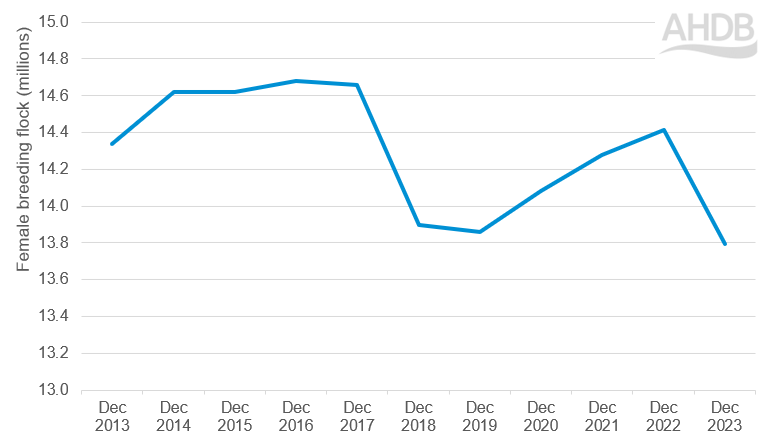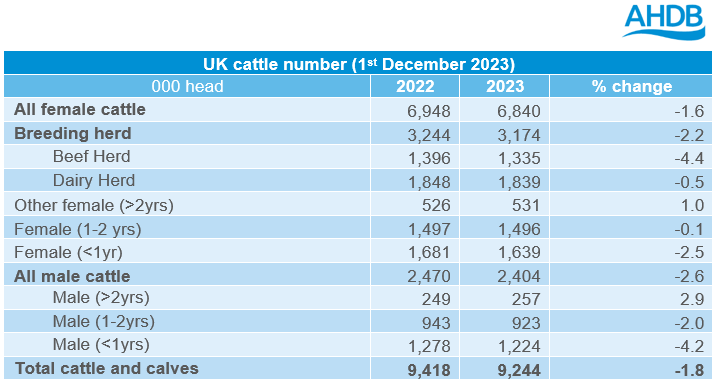Defra’s December survey reveals a drop in UK sheep and cattle populations
Thursday, 4 April 2024
Sheep
According to Defra’s latest census from 1 December 2023, the total UK sheep flock has seen a significant drop of 5.1% (-1.14m head) year-on-year, to 21.2 million head.
A 616,000 head (-4.3%) contraction in the female breeding flock accounted for most of the total reduction, although the “all other sheep and lambs” category saw a more pronounced drop in terms of percentage (-6.6%).
Total breeding flock in the last 10 years
Source: Defra
The latest data shows that December 2023 held the lowest number of breeding females seen on record (according to Defra data reaching back to 1996), now at 13.8 million head. These trends follow the trajectory seen in the June census. Reduced lamb production is expected in 2024, following the contraction of the breeding flock.
Cattle
Meanwhile, the UK cattle population dipped to 9.2 million head in December 2023, 1.8% below the previous year.
The total breeding herd (which makes up 34% of the total population) had declined by 2.2% and stood at 3.2 million head at time of the survey. The reduction was driven by a decline in the beef breeding herd of 61,000 head (-4.4%). The dairy breeding herd recorded marginal contraction of 9,000 head (-0.5%).
UK cattle population
Source: Defra
The number of females between 1 and 2 years dipped from the high number recorded in June but remained stable on the year. Meanwhile, the number of females under the age of 1 year continued to tighten, by 42,000 head against December 2022.
Although there was a rise in the population of male cattle over the age of 2 years, the number of males younger than 2 years old experienced a decline of 73,000 head. This meant the total male cattle number contracted by 2.6% on the year.
The reduction in youngstock numbers aligns with trends in calf birth registrations. In 2023, the number of calves born in GB fell more steeply than in previous years, driven by fewer calves born to the suckler herd. Meanwhile, registrations of dairy-beef animals continued to rise, reflecting uptake in beef semen among dairy producers. For a more in-depth look into GB dairy-beef cattle numbers, see here.

Sign up for regular updates
You can subscribe to receive Beef and Lamb market news straight to your inbox. Simply fill in your contact details on our online form.
While AHDB seeks to ensure that the information contained on this webpage is accurate at the time of publication, no warranty is given in respect of the information and data provided. You are responsible for how you use the information. To the maximum extent permitted by law, AHDB accepts no liability for loss, damage or injury howsoever caused or suffered (including that caused by negligence) directly or indirectly in relation to the information or data provided in this publication.
All intellectual property rights in the information and data on this webpage belong to or are licensed by AHDB. You are authorised to use such information for your internal business purposes only and you must not provide this information to any other third parties, including further publication of the information, or for commercial gain in any way whatsoever without the prior written permission of AHDB for each third party disclosure, publication or commercial arrangement. For more information, please see our Terms of Use and Privacy Notice or contact the Director of Corporate Affairs at info@ahdb.org.uk © Agriculture and Horticulture Development Board. All rights reserved.



